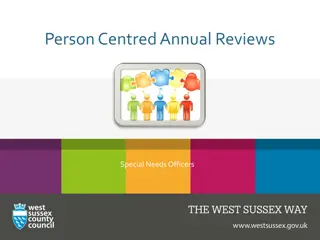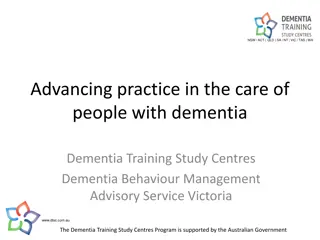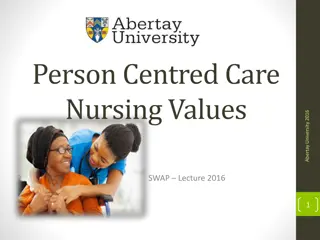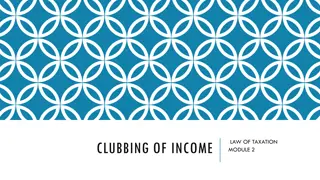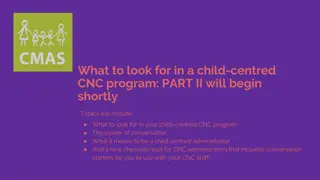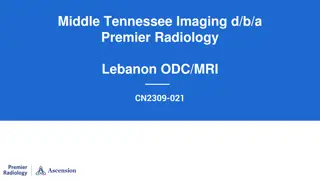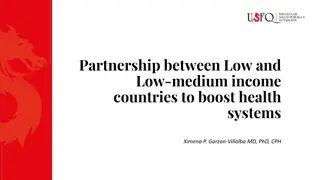Person-Centred Diagnostic Imaging Services in Low- and Middle-Income Countries
Exploring the challenges and solutions in offering person-centred diagnostic imaging services in low- and middle-income countries, this research highlights the importance of treating patients as individuals, understanding their unique needs, and promoting quality and safety through partnerships and education.
- Diagnostic imaging
- Low-income countries
- Patient-centered care
- Quality and safety
- Healthcare services
Download Presentation

Please find below an Image/Link to download the presentation.
The content on the website is provided AS IS for your information and personal use only. It may not be sold, licensed, or shared on other websites without obtaining consent from the author. Download presentation by click this link. If you encounter any issues during the download, it is possible that the publisher has removed the file from their server.
E N D
Presentation Transcript
Achieving person-centred diagnostic imaging services in low-and middle- income countries: barriers and strategies Alberta Naa Afia Adjei1, Andrew Donkor1,2, Yaw Amo Wiafe1 1. Department of Medical Diagnostics, Faculty of Allied Health Sciences, Kwame Nkrumah University of Science and Technology, Kumasi, Ghana 2. IMPACCT, Faculty of Health, University of Technology Sydney, Australia 1
Content Introduction Low-and-middle income country Person centered diagnostic imaging care Barriers and strategies in person centered diagnostic imaging care Conclusion References 2
Introduction Low-and-middle income countries, gross national income(GNI) per capita is $13,205 or less. A total 136 countries: 28 low-income ($1,085 or less) 54 lower-middle-income ($1,086 to $4,255) 54 upper middle-income ($4,256 to $13,205) (World bank group, 2023) 3
Person-centered diagnostic imaging care Key elements: Treating patients as individuals; Recognising that all individuals accessing diagnostic imaging services have a unique clinical history, physical, social and economic needs; Recognising that individuals accessing diagnostic imaging services need a comfortable environment; Communicating effectively with each individual; and Respecting the dignity, privacy and confidentiality of individuals accessing diagnostic imaging services. 4
Useful lessons for person centered care 1. Strengthening partnerships to increase access to diagnostic imaging services 2. Providing leadership to improve responsiveness 3. Promoting diagnostic imaging information and education through improvement in patients health literacy 4. Developing and allocating diagnostic radiographers to promote quality and safety 5
5As of access Access is the ability of the client to seek and obtain safe and high-quality diagnostic imaging services. Diagnostic imaging services should be organised and delivered according to the preferences, needs and values of the individual patient. Levesque framework 7
Access barriers Based on the Levesque framework, access barriers include: Availability and accommodation problems Affordability problems Acceptability problems Approachability problems Appropriateness problems 8
Strategies to improve access Strengthening partnerships to increase access to diagnostic imaging services Partnership with private and charitable sectors Proper planning for equipment distribution Approachable and affordable services 9
Responsiveness Responsiveness involves the experience of patients interactions with their health systems, which confirms or disconfirms their initial expectations (Mirzoev & Kane, 2017). It is a key outcome on which health systems, including diagnostic imaging services, are judged. 10
Barriers to responsiveness Poor quality of basic amenities Lack of respect for autonomy Responsiveness Lack of prompt attention Lack of adequate confidentiality 11
Strategies to improve responsiveness The six point leadership framework of South Western Sydney Local Health District Setting direction Developing self Developing and enabling others Fostering and building positive relationships Communicating with influence Innovating and leading change (SWSLHD, 2017). 12
Patient information and education Health literacy has been defined as the capacity of an individual to access, process and comprehend health information and services required to make effective health decisions (S rensen et al., 2012). Many patients in LMICs report difficulties in obtaining relevant information about their diagnostic imaging procedures. 13
Poor patient- centered communication Barriers to patient information and education Lack of patient educational resources Patient information Lack of knowledge on diagnostic imaging and its related benefits 14
Window of opportunities for patient education Due to busy schedules of radiographers and patients, radiographers can take opportunities for patient information and education: During the explanation of the diagnostic imaging procedures; When responding to the patient concerns; As part of the instructions needed to prepare for the diagnostic imaging procedure; and During instruction for follow-up care. (Ehrlich & Coakes, 2020). 15
Strategies for patient information and education Training interventions should be designed to improve diagnostic imaging professionals communication skills to help involve patients in their diagnostic imaging care. Communication frameworks such as AIDET, RESPECT and PREPARED can be adopted in such instances. 16
PREPARED P- Prepare for the discussion R- Relate to the person E-Elicit patient and caregiver preferences P- Provide information A- Acknowledge emotions and concerns R- Realistic hope E- Encourage questions D- Document (Clayton, Hancock, Butow, Tattersall, & Currow, 2007; Mutha, Allen, & Welch, 2002; Studer Group, 2010) 17
Diagnostic imaging workforce The diagnostic imaging workforce challenges in LMICs are complex and multifaceted. Demand for diagnostic imaging services is evolving rapidly and continues to challenge the diagnostic radiographers ability to deliver safe and high-quality services in LMICs. 18
Barriers to diagnostic imaging workforce 19
Barriers to diagnostic imaging workforce Lack of coordination in diagnostic radiography workforce planning Inequitable distribution of diagnostic radiographers Changing models of technology on patient care 20
Strategies for workforce Formal relationships should be built between urban and rural diagnostic imaging facilities to rotate training students and build local capacity Incentive and non-incentive strategies should be designed to encourage diagnostic imaging professionals to locate and remain in rural areas Fellowship training in diagnostic radiography can improve the confidence of diagnostic radiographers and their preparedness to assume leadership level of responsibility as specialists and consultants 21
Conclusion It can be seen that the barriers are complex. However, by strengthening partnerships, providing leadership, promoting health literacy and investing in the training of diagnostic radiographers, person-centred diagnostic imaging care can be achieved in LMICs. There is also the need to understand how well integrated person-centred care has become in the education, training and core competences of diagnostic imaging professionals. 22
References Clayton, J. M., Hancock, K. M., Butow, P. N., Tattersall, M. H., & Currow, D. C. (2007). Clinical practice guidelines for communicating prognosis and end-of-life issues with adults in the advanced stages of a life- limiting illness, and their caregivers. The Medical Journal of Australia, 186(12), S77-S108. Ehrlich, R., & Coakes, D. (2020). Patient care in radiography: with an introduction to medical imaging (10 ed.). Missouri: Elsevier. Levesque, J.-F., Harris, M. F., & Russell, G. (2013). Patient-centred access to health care: conceptualising access at the interface of health systems and populations. International Journal for Equity in Health, 12(1), 18-26. doi:10.1186/1475-9276-12-18 Mirzoev, T., & Kane, S. (2017). What is health systems responsiveness? Review of existing knowledge and proposed conceptual framework. BMJ Global Health, 2(4), e000486-e000496. doi:10.1136/bmjgh-2017- 000486 Mutha, S., Allen, C., & Welch, M. (2002). Toward culturally competent care: a toolbox for teaching communication strategies. San Francisco, CA: Center for the Health Professions, University of California. 23
References cont. S rensen, K., Van den Broucke, S., Fullam, J., Doyle, G., Pelikan, J., Slonska, Z., & Brand, H. (2012). Health literacy and public health: a systematic review and integration of definitions and models. BMC Public Health, 12(1), 1-13. Studer Group. (2010). The nurse leader handbook (1 ed.). Parkway: Fire Starter Publishing. SWSLHD. (2017). Our leadership strategy: A shared approach to leadership 2017-2021. Sydney: ZEST Health Strategies. World Bank Group. (2023). World Bank country and lending groups. Washington, D.C: The World Bank Group Retrieved from https://datahelpdesk.worldbank.org/knowledgebase/articles/906519-world-bank- country-and-lending-groups 24




